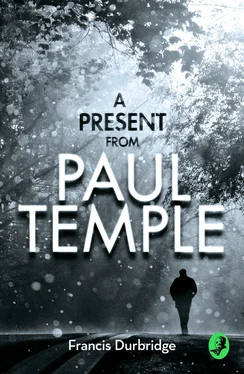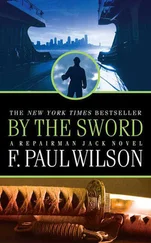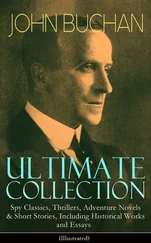FRANCIS DURBRIDGE
A Present from Paul Temple
AND
Light-Fingers
Two Christmas Short Stories

An imprint of HarperCollins Publishers
1 London Bridge Street
London SE1 9GF
www.harpercollins.co.uk
First published in Great Britain in
The Daily Mail Annual for Boys and Girls 1950, 1951
Introduction from the Paul Temple Library 1964
Copyright © Francis Durbridge 1950, 1951 and 1964
All rights reserved
Francis Durbridge has asserted his right under the Copyright,
Designs and Patents Act, 1988 to be identified as the author of this work
Cover design © HarperCollins Publishers Ltd 2015
Cover image © Shutterstock.com
A catalogue copy of this book is available from the British Library.
This novel is entirely a work of fiction. The names, characters and incidents portrayed in it are the work of the author’s imagination. Any resemblance to actual persons, living or dead, events or localities is entirely coincidental.
All rights reserved under International and Pan-American Copyright Conventions. By payment of the required fees, you have been granted the non-exclusive, non-transferable right to access and read the text of this e-book on screen. No part of this text may be reproduced, transmitted, down-loaded, decompiled, reverse engineered, or stored in or introduced into any information storage and retrieval system, in any form or by any means, whether electronic or mechanical, now known or hereinafter invented, without the express written permission of HarperCollins.
Ebook Edition © June 2015 ISBN: 9780008148003
Version: 2015-11-04
Contents
Cover
Title Page FRANCIS DURBRIDGE
Copyright An imprint of HarperCollins Publishers 1 London Bridge Street London SE1 9GF www.harpercollins.co.uk First published in Great Britain in The Daily Mail Annual for Boys and Girls 1950, 1951 Introduction from the Paul Temple Library 1964 Copyright © Francis Durbridge 1950, 1951 and 1964 All rights reserved Francis Durbridge has asserted his right under the Copyright, Designs and Patents Act, 1988 to be identified as the author of this work Cover design © HarperCollins Publishers Ltd 2015 Cover image © Shutterstock.com A catalogue copy of this book is available from the British Library. This novel is entirely a work of fiction. The names, characters and incidents portrayed in it are the work of the author’s imagination. Any resemblance to actual persons, living or dead, events or localities is entirely coincidental. All rights reserved under International and Pan-American Copyright Conventions. By payment of the required fees, you have been granted the non-exclusive, non-transferable right to access and read the text of this e-book on screen. No part of this text may be reproduced, transmitted, down-loaded, decompiled, reverse engineered, or stored in or introduced into any information storage and retrieval system, in any form or by any means, whether electronic or mechanical, now known or hereinafter invented, without the express written permission of HarperCollins. Ebook Edition © June 2015 ISBN: 9780008148003 Version: 2015-11-04
INTRODUCTION: How I Created Paul Temple INTRODUCTION How I Created Paul Temple It was in April 1938 that I created the character of ‘Paul Temple’ and Martyn C. Webster, the famous BBC Producer, put the first of the series on the radio. I had been thinking about the character for almost three months before I actually came across the person whose manner, voice and attitude suggested to me the man-of-the-world novelist with an interest in criminology. I was hurrying to catch a train to Birmingham, where I lived in those days, after a visit to London. The train was, in fact, already moving as I scrambled in. There was one other occupant of the compartment and he slowly raised his head at my unexpected entrance. As far as I can remember he was tall and dark and was reading a battered copy of Arnold Bennett’s Imperial Palace . We never spoke, but for some unknown reason after he had left the train – he got out at Leamington Spa – I started thinking about him. I remembered the quiet, casual manner in which he had inserted a cigarette in an unusual type of holder; the keen, intelligent face; the smiling eyes a little crinkled at the corners; the friendly nod he gave the inspector as he showed his season ticket. The man had other characteristics which fascinated me. He was obviously interested in literature and not merely a casual reader; one could tell that by the way he pondered over the novel he was reading. That night, when I arrived home, I started to read Somerset Maugham’s First Person Singular , and I came across the following paragraph: ‘I think, indeed, that most novelists, and surely the best, have worked from life. But though they have had in mind a particular person, this is not to say that they have copied him, or that the character they have devised is to be taken for a portrait. In the first place they have seen him through their own temperament, and if they are writers of originality this means that what they have seen is somewhat different from fact.’ This passage by Somerset Maugham made me think again about the man on the train. I jotted down a few details about him. From these details, plus, of course, a certain amount of elaboration, emerged the character of ‘Paul Temple’. Francis Durbridge 1964
A Present From Paul Temple
Light-Fingers
SOLUTION TO: Light-Fingers
About the Author
Also in This Series
About the Publisher
INTRODUCTION
How I Created Paul Temple
It was in April 1938 that I created the character of ‘Paul Temple’ and Martyn C. Webster, the famous BBC Producer, put the first of the series on the radio.
I had been thinking about the character for almost three months before I actually came across the person whose manner, voice and attitude suggested to me the man-of-the-world novelist with an interest in criminology. I was hurrying to catch a train to Birmingham, where I lived in those days, after a visit to London. The train was, in fact, already moving as I scrambled in.
There was one other occupant of the compartment and he slowly raised his head at my unexpected entrance. As far as I can remember he was tall and dark and was reading a battered copy of Arnold Bennett’s Imperial Palace . We never spoke, but for some unknown reason after he had left the train – he got out at Leamington Spa – I started thinking about him.
I remembered the quiet, casual manner in which he had inserted a cigarette in an unusual type of holder; the keen, intelligent face; the smiling eyes a little crinkled at the corners; the friendly nod he gave the inspector as he showed his season ticket.
The man had other characteristics which fascinated me. He was obviously interested in literature and not merely a casual reader; one could tell that by the way he pondered over the novel he was reading.
That night, when I arrived home, I started to read Somerset Maugham’s First Person Singular , and I came across the following paragraph:
‘I think, indeed, that most novelists, and surely the best, have worked from life. But though they have had in mind a particular person, this is not to say that they have copied him, or that the character they have devised is to be taken for a portrait. In the first place they have seen him through their own temperament, and if they are writers of originality this means that what they have seen is somewhat different from fact.’
Читать дальше











